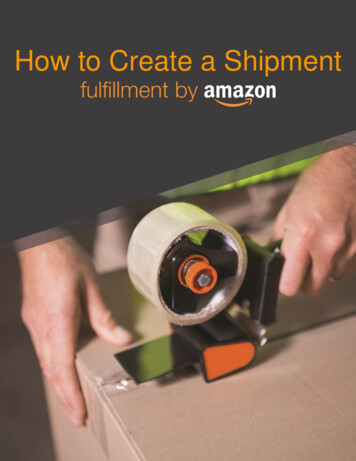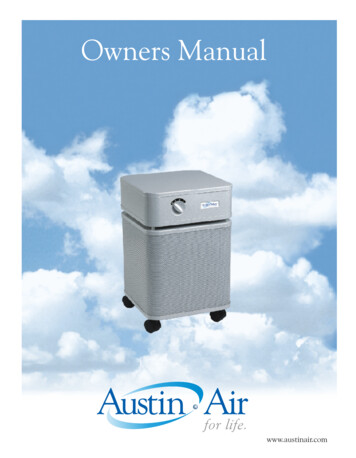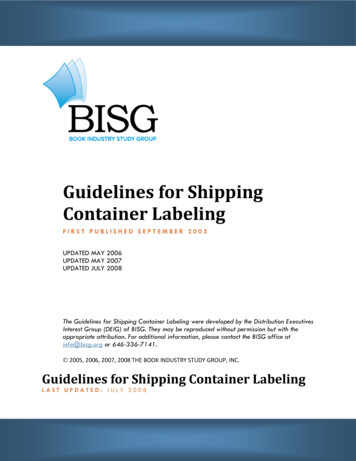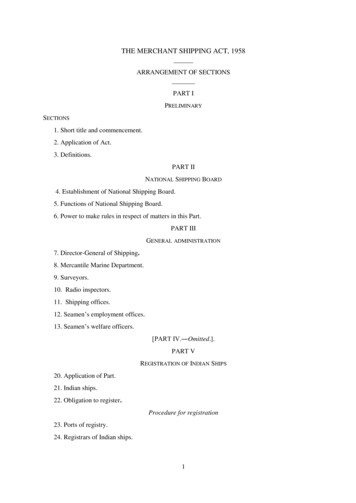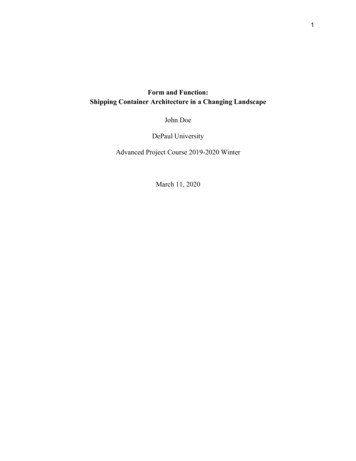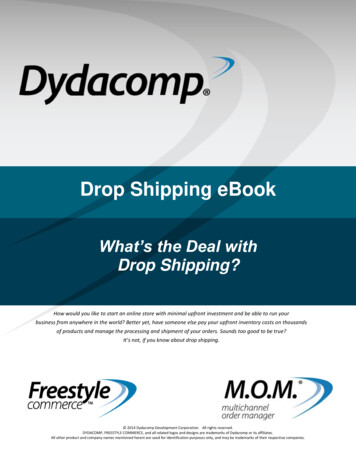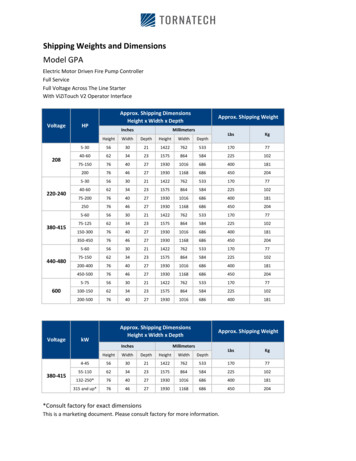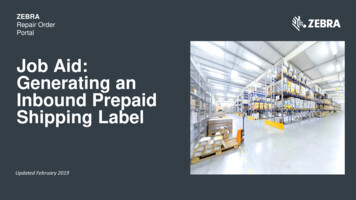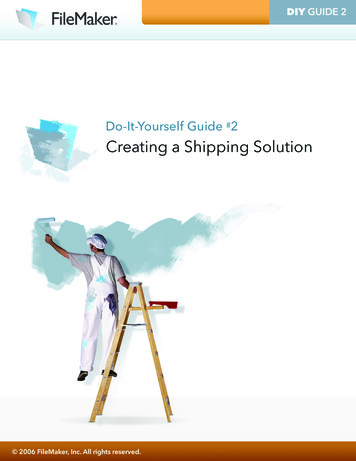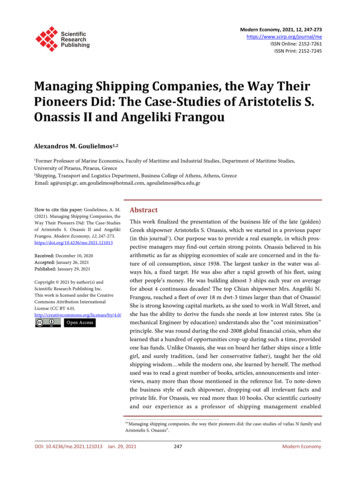
Transcription
Modern Economy, 2021, 12, 247-273https://www.scirp.org/journal/meISSN Online: 2152-7261ISSN Print: 2152-7245Managing Shipping Companies, the Way TheirPioneers Did: The Case-Studies of Aristotelis S.Onassis II and Angeliki FrangouAlexandros M. Goulielmos1,2Former Professor of Marine Economics, Faculty of Maritime and Industrial Studies, Department of Maritime Studies,University of Piraeus, Piraeus, Greece2Shipping, Transport and Logistics Department, Business College of Athens, Athens, Greece1AbstractHow to cite this paper: Goulielmos, A. M.(2021). Managing Shipping Companies, theWay Their Pioneers Did: The Case-Studiesof Aristotelis S. Onassis II and AngelikiFrangou. Modern Economy, 12, 247-273.https://doi.org/10.4236/me.2021.121013This work finalized the presentation of the business life of the late (golden)Greek shipowner Aristotelis S. Onassis, which we started in a previous paper(in this journal1). Our purpose was to provide a real example, in which prospective managers may find-out certain strong points. Onassis believed in hisarithmetic as far as shipping economies of scale are concerned and in the future of oil consumption, since 1938. The largest tanker in the water was always his, a fixed target. He was also after a rapid growth of his fleet, usingother people’s money. He was building almost 3 ships each year on averagefor about 4 continuous decades! The top Chian shipowner Mrs. Angeliki N.Frangou, reached a fleet of over 18 m dwt-3 times larger than that of Onassis!She is strong knowing capital markets, as she used to work in Wall Street, andshe has the ability to derive the funds she needs at low interest rates. She (amechanical Engineer by education) understands also the “cost minimization”principle. She was round during the end-2008 global financial crisis, when shelearned that a hundred of opportunities crop-up during such a time, providedone has funds. Unlike Onassis, she was on board her father ships since a littlegirl, and surely tradition, (and her conservative father), taught her the oldshipping wisdom while the modern one, she learned by herself. The methodused was to read a great number of books, articles, announcements and interviews, many more than those mentioned in the reference list. To note-downthe business style of each shipowner, dropping-out all irrelevant facts andprivate life. For Onassis, we read more than 10 books. Our scientific curiosityand our experience as a professor of shipping management enabledReceived: December 10, 2020Accepted: January 26, 2021Published: January 29, 2021Copyright 2021 by author(s) andScientific Research Publishing Inc.This work is licensed under the CreativeCommons Attribution InternationalLicense (CC BY en Access“Managing shipping companies, the way their pioneers did: the case-studies of vafias N family andAristotelis S. Onassis”.1DOI: 10.4236/me.2021.121013Jan. 29, 2021247Modern Economy
A. M. Goulielmosus to single out the management ways and the principles applied by these twomanagers. The end purpose was to teach readers of how shipping businesscan be carried-out with success given the changes occurred.KeywordsA Case-Study Related to Aristotelis S. Onassis, also to Angeliki Frangou,Liberty Ships, Onassis’ Animal Spirits1. IntroductionIt has been written2 that Greek shipowners are of 2 at least types (Graph 1).The traditionalists are those with long-established names, who were enduringfor several generations, and at least five. They usually originate from 1 familyand 1 island with a seafaring tradition, such as Andros and Chios, prior to 1800s.These companies are usually characterized by a slow and steady growth. An example is the late Stavros Livanos3. The Parachutists are those, a first-generationowner, with no particular background in shipping, who suddenly landed on maritime sea, during the years following the 2nd World War.The traditionalists were endowed by the 107 surplus ships for Liberty (presented below), available (lend-lease) at low prices in 1946 by USA Governmentto Greek shipowners. The Parachutists had a sudden and fast growth. Onestrong example is Onassis. In Greece, ship owning is a way of life, and not only aprofession, and prior knowhow is not a necessary condition to become a shipowner. Best example is the “Martinos family” (1969), belonging rather to Parachutists. It created 3 top shipping companies4 one for each brother- and aGraph 1. The 2 types of greek Shipowners according to Bothwell (1982). Source: author.Bothwell, J. H. (1982) Com.He came from Chios (Kardamyla), born in 1887. He was a Chief Engineer. In 1917 settled-down inLondon establishing a shipping office. After 2nd World War he owned over 30 vessels of which 9new-buildings. In 1948 obtained a tanker of 26,000 tons. He passed away in 1956. He was a lover ofmoney.4Thenamaris; Minerva and Eastern owning about a total of 25 m dwt in 2018! There is a large number of companies created by non-traditional shipowners emerging after 1960s. As we mentionedelsewhere 1/3 of companies come from ex-sea officers (Captains and Engineers). One third iscreated by shore industrialists and 1/3 are traditionalists out of 1000 at least shipping companies.We may stress here the importance of the maritime cluster existing in Greece, where one learns thebusiness of shipping, finds crews and many former senior staff of shipping companies create theirown shipping company, best example being Costas Priftis, of Thenamaris.23DOI: 10.4236/me.2021.121013248Modern Economy
A. M. Goulielmostwo-generation company for Thenamaris. This family started with an old, usingsteam, used5 dry cargo ship, and hired experienced departmental/divisionalmanagers till owners learned the business. Tradition is truly a strong motiveamong Greeks not only in Shipping but also in national issues.2. Aim and Organization of PaperWe will present one of the past and one of the present Greek shipowners asManagers, so that to reveal their management style, behind their fleet, so that toteach present or future managers by their example. The selection has been madeso that to have an old and a modern shipowner. This work emanated from thefact that certain shipping managers have built great fortunes and to the studentsof shipping business there is always the inclination to find-out how and why?This work is structured and organized in three parts, as follows: Next is a literature review followed by part I dealing with the case-study of the 107 ships builtfor liberty in 1941-1945. Then is Part II dealing with Onassis business life: acase-study II, followed by part III: the case-study of Mrs. Angeliki N. Frangou.Finally, we conclude.3. Literature ReviewLowry N. (2003)6 wrote for Onassis a book. For this paper I had the same idea asMpatis (1999) had. The idea came to Mpatis during a presentation of a numberof bachelor degree essays in the Dept. of Maritime Studies (University of Piraeus) (in 1998). The presentations were overwhelmed by statistics, but therewas no reference to the men behind them Mpatis decided7 to write a book toThe obstacle to become a shipowner is to find, or have, the own capital in USA , most probably a40% of the value of a ship. This is a necessary condition. Overaged ships are cheaper and Greeksmost frequently than never bought such ships. In old times Greeks gathered the savings of say about100 persons to buy a ship, till Greeks became rich as nowadays.6I thank the Foundation for sending me one copy.7“Vision magazine”, Greek shipping Vision; date unknown, pp. 110-112.5DOI: 10.4236/me.2021.121013249Modern Economy
A. M. Goulielmosshow-up the human element! We decided to write a number of papers for thesame reason.Randoy et al. (2003) studied the good corporate governance in maritimefirms, empirically testing-among Norwegian and Swedish firms only if thefounding family leader—CEO, increases performance, (ROA-return on assets),in shipping, and if board’s independence is related to higher performance8. Wemay ask for further research: does shipping companies’ fast decision-makingprovide higher profits, together with perfect timing, when only one single manager does it? Does in decision-making family hierarchy prevail? What conclusion is drawn if we compare the performance of personal companies with familyones?Stopford M. (2009) mentioned Onassis repeatedly and said that shipping volatility created him (p. 3). Onassis in 1956 earned 80 m due to 1st Suez Canal closure, but he was wrong believing that this will last for years (p. 702). His aideCostas Gratsos told him to use the “time charters” and he, secretly, chartered12 tankers to Esso for 3 years and 3 months!Koufopoulos et al. (2010) used a maritime directory, in 2006-7, to study-outthe governance structure of the Greek owned companies having more than 5vessels. This coupled with 179 questionnaires addressed to their managing directors. Twenty-seven responses were received-back only ( 15%). They found-out(Table 1):Further research may answer: is the family hierarchy respected during control(?) and what happens if managers are e.g., two or 3 (of equal standing) brothers?Interesting is also what happens if there are disagreements between father andson, and between brother and brother9?Pedagogical is the case of the ex-Greek company “Stelmar Shipping Co Ltd”Table 1. Greek owners with more than 5 vessels & their governance structure (2006-2007).Family is: ownerand managerThe founding (family)member is the leaderThe international activityprovides incentives fordecision-makers tooptimize returnsSmall board size(5-7)CEO is alsoBoard’sChairman (bymajority)Company’s directorsare also board-members(by majority) (*)A starting trend toadopt more structuredgovernance systemsA hesitation isnoted to evaluateCEO & his/herperformanceNo externalboard members(by majority)(**)Frequent boardmeetingsBoards contributemost to strategic processSource: author, based on authors’ paper. (*) Stelmar shipping company adopted this. (**) The Vafias group,presented in Goulielmos (2020), had external board members.Notable is that out of 56 quotations only 4 are maritime of which one in Norwegian The paper showed indirectly the poverty of research on matters of companies, which are thoughtto be confidential. From 84 quotations only 15% were shipping and from them some hardly relevant to paper’s topic.89DOI: 10.4236/me.2021.121013250Modern Economy
A. M. Goulielmosfounded in 1992 by Stelios Hadjiioannou of a Cypriot family of shipowners, andlisted in NYSE in 2001. This was a case of confrontation between owner Steliosand 2 members of company’s Board of Directors (CEO and CFO). So, first lesson is one to be careful about what members one invites in company’s board10,and what % of shares has the founder, being that not below 51%. Shipping business reality has taught us that the personal interest is above company’s interest,despite what Fayol11 asked for in 1916. Fayol advanced 14 principles of management (Robbins & Coulter, 2018: p. 70), of which one said: “subordination of individual interests to the general interest”! Stelmar finally sold12 to OSG- Overseas Shipholding Group in 2004 against 843 m.Lorange & Fjeldstad (2010) posed one question and gave a positive answerwith 3 reasons. The question was: Does the organization of international shipping companies deserve special attention? They recognized that shipping has amore important and effective role to play after the opening-up of the new tradeswith over-populated areas, like China and India, and other S E Asia countries.Given market’s volatility companies had to be organized and managed properlyto make high stakes and rapid asset-playing decisions (Graph 2).A Greek shipowner (Danaos) said that globalization made possible by containerization. In what particular way shipping helps humanity? Table 2 illuminatesthis.Graph 2. Special features of shipping industry of managing & organizing.Source: author, from the paper mentioned.Table 2. Ships and their particular % role in the transport (shipments) of certain cargoes.Type of shipPhosphate rock% of total cargo Panamax2022404345%Handy80%81550%55%Source: Data from fearnleys’ & LSE, undated.Worth noting is that Stelios had a 13% of company’s shares, his brother Polys had 7% and her sister Clelia had 7%, a total of 27%.11Translated into English in 1949 by Sir Isaak Pitman & Sons, Lon.12If a buyer agrees to retain certain members of the boards of directors after sale of the company,these agree strongly for this take-over!10DOI: 10.4236/me.2021.121013251Modern Economy
A. M. GoulielmosAs shown Capes carry the majority of iron-ore required for buildings, publicworks etc., along with Handy carrying bauxite and alumina, and feeding peoplewith Grain. This last type helps also agriculture (80%). Capes and Panamax helpwith coal, as a source of energy, almost equally. This is a pre-China etc. pictureas China is not mentioned and India is mentioned for providing iron-ore to Japan and Korea. China dominated the iron-ore transport gradually since 1986with 190 mt, in 2004, out of 590 m ( 32%).Moreover, Lorange & Fjeldstad (2010) pointed-out further the changes thatoccurred in shipping industry since 1990 (Graph 3).Managers have to realize the main characteristics of Shipping Industry(Graph 4).Summarizing, we believe that managing shipping companies is better to beone-man show, and decision-making to be again one-man show, but this has tocome out with a contribution from all relevant departments. Family structures inGreek shipping maintain family hierarchy in decision-making and this is moreGraph 3. Major changes in Shipping Industry, 1990-2000. Source: author, based on papermentioned.Graph 4. Major characteristics of Shipping Industry, 2010. Source: author, based on paper mentioned.DOI: 10.4236/me.2021.121013252Modern Economy
A. M. Goulielmoseffective. When there is a disagreement, father’s opinion prevails, but when father dies sons or daughters set-off in their new individual companies. This alsohas happened with brothers (Polemis; Procopiou; Martinos and others).Perfect timing, however, is the King and the successful shipping managershave done it. Greeks by using a number of economic principles succeeded toexcel and to approach, but not to reach perfect timing. This we believe is the topcriterion of managing and organizing a shipping company successfully. By pursuing a perfect timing, this presupposes certain times waiting with utmost patience. Let us take an example in answering the question: when was a perfecttiming to order and build tankers between 1980 and 1992 (January)? This isshown in Figure 1.Figure 1 indicates that the lowest price, over the 1980-1992 period, to build aVLCC is in Jan. 1986. This consists a perfect-timing (with probable delivery in1988 Jan.). The competitive advantage of such a decision is obvious: one has topay 38m for a VLCC, against what he/she should pay in 1991 of 95m. The later owner will have a higher capital cost of 57m and for a 15- yearly lifetime ofthe ship 10,411 per day additional cost. However, to build a ship cheaply is oneimportant factor, but to earn maximum earnings is another (Figure 2). Figure 2indicates that the highest earnings are obtained in March 1991, and in May 1991,and not in 1986 Jan. What one has to do (Table 3)?Figure 1. Prices for newly-built tankers, 1980-1992 (Jan.). Source: ClarksonResearch Studies Ltd.DOI: 10.4236/me.2021.121013253Modern Economy
A. M. GoulielmosFigure 2. Tanker earnings, 1990-1992 (April). Source: Clarkson research studies ltd.Table 3. Perfect timing for building and for earnings.Per dayearningsEarnings13 for a hireof 38 months, from1988 Jan.-to 1991,MarchRemarks1988 Jan. 15,000hypothetical 16.62mA low freight ratesperiodMarch 1991 45,000 realEarnings for hire in1991-1994 for: 38months 49.93mPrice difference 42m (80-38) 49.9mEarning difference 33.31( 49.93 16.62 33.31m)Perfecttiming tobuildDelivery(probably)1986 Jan.Perfecttiming forearningsBad timing tobuild: 19891991 MarchPrice 80Source: author.As shown, the perfect-timing for building is in 1986, at 38m and this provides a benefit of 42m, against 80m, which is the price prevailing in 1989 (theyear of perfect timing for earnings). Thus, a theoretical loss comes from theEarnings are always calculated for 350 days per annum, while cost over 365 days.13DOI: 10.4236/me.2021.121013254Modern Economy
A. M. Goulielmoslower earnings of 30,000 per day and for 350 days or 33.31m for a hypotheticalhire of 38 months (1988-1991). There is a final surplus (42 m from buildingprices) and a 33.31 m loss from earnings, which gives a final 8.69m benefit,between the two perfect-timing decisions to build and to charter. Thus, thiswhole example is in favor of building cheap and the suggestion is to order at arock-bottom newbuilding price no matter what the freight rate is.Part I: The case-study of the 107 ships built for Liberty in 1941-1945.The end of 2nd World War found USA with 2751 laid-up commercial ships,which built in 17 USA shipyards (from 27/09/1941 to 30/10/1945), of about27.5m dwt, for the war. They were built for the 1sttime using the “electro-welding”method in fixing (the iron) plates together, instead of using iron rivets, as hitherto, something which made ships heavier14. USA’s aim was to build theseships fast, so that to replace the vessels foundered by German submarines Theywere named “Liberty” ships (Scan 1) indicating their purpose to contribute towards world’s liberty. Their cost was about 2m each.USA, after the war, wanted to dispose (lend-lease) abroad above Liberties atfavorable terms with a credit facility15. Greek shipping had losses during 2ndWorld War amounting to 72% - 75% of its 1938 fleet (GRT). Onassis calculatedthat Greeks lost ships valued 153m during the war (an amount received-backpartly from insurance compensations and partly from companies’ profits). Greekshipowners in order to invest these funds, which were held by Greek State, in amore secure way, wanted to buy 100 Liberty ships.Greek State intervened to USA so that Greeks to obtain 98 Liberty ships( 550,000 each; 25% cash; 75% in 17 annual installments; at 3.5% interest rateand Greek state’s guarantee). Latter this modified and shipowners paid 50% cashScan 1. One liberty out of 98 sold to Greeks by USA, 1947. Source:Argo shipping periodical, 1986; modified.Indirectly we see here the remarkable technological advance by going from iron to steel! Ships became lighter, and thus larger, plus other benefits. Japanese have invented also an even lighter steel.Some have wondered if these ships built with “improved” steel plates, produced less resistance inbad weather, and thus more marine accidents?15The history is repeated, however, as something similar happened at the end of Great War in 1918,where more than 4000 sailing ships were laid-up in Danube, and other rivers, most bought byGreeks.14DOI: 10.4236/me.2021.121013255Modern Economy
A. M. Goulielmosand a 10% of ships’ value only guaranteed16. A 1st mortgage on their 50% valuewas written in favor of Greek State. These ships had, however, to flow Greek flagand employ Greek crews.The ships for Liberty underwent repairs of about 100,000, or over, each; inaddition, Greeks obtained and 7 T2 tankers at a price round 2m each. The 107Liberty ships of about 730,000 GRT were the only solution, at that time, forGreek shipowners as Greek shipyards did not exist and funds in US were alsonot available In 1948, Greeks owned ships amounted to 2.52 m GRT; and over364 m dwt by 2020!The buyers had to have US —Greek shipowners had only English pounds17also bound (locked by Greek State) in UK banks- and the transfer into wascomplicated. Global shipping demand was in hands of USA, as it has not beeninvolved in the war from the beginning. The Liberties covered up to 58% ofGreek flagged shipping in 1948-1949 and remained 40 years in the fleet(-1986) Thus they produced a great advantage and benefit to Greek flaggedshipping. In addition, Greece received, in kind, a gesture of gratitude for fightingfor liberty in allies’ and USA’s side and paying a toll.Moreover, the Greek state organized the entire project together with “NYGreek shipowners”. The 2 first criteria set for one to buy the Liberties were fair,we believe: 1) Greek owners should have lost ships during the War, and perhapsto receive ships in analogy of losses suffered, and 2) to have flown Greek flag.And 3) to be members of the “NY Greek shipowners’ union”—something weconsider to be unfair. Onassis had none of the above criteria A number of 47Greek shipowning-families, or 66 shipowners-traditionals, obtained 98 Liberty18.A list of Greek shipowners, who bought the 98 Liberties can be found in Goulielmos (2020).Part II: Onassis19 Business Life20: A Case-Study iiWe were impressed by Onassis, O thereafter, written will establishing theState’s guarantee was for 40m-ended in 1954 and in 1955; shipowners’ counter-guarantee was 5.5m, which ended in 1954 and 1955 too (Laws 747 and 150/1946).17The ships lost due to war-cause were insured in UK insurance market for war-risks and thusGreek shipowners had funds to buy Liberties.18Sixty-six (66) ships obtained by 18 traditional families; these families that have obtained morethan 1 Liberty were: Fafalios 2, Andreadis(*) 2, Vergotis 3, Goulandris(**) 3, Gratsos(***) 4, Elliniki4, Epiphaniadis 3, Kassos SA 3, Kulukuntis 7, Livanos 11, Lemos(****) 5, Los 2, Michalinos 2, Nicolaou 2, Nomikos(5*) 2, Kumantaros 4 (1 with Niarchos(6*), Pateras 5 & Stathatos 2. (*) He wasborn in Chios (Vrontados) in 1905. A University Professor. He passed away in 1989. (**) V.J. wasan M.P. born in Andros in 1886 and Captain. In 1925 established -with his brothers-the company“Goulandris Bros Ltd”. (***) Born in Kassos in 1898. He passed away in 1998. (****) Lemos, C Mborn in Oinousses in 1911 and passed away in 1995. One of the 5 major global shipowners. In 1937,together with his cousins Costas and Markos Lyras, established -in London- the shipping office:“Lyras & Lemos”. After 2nd World War went to NY. (5*) Lukas Nomikos born in Oia next to Santorini in 1886 and was a seaman. He passed away in 1937. (6*) Born in Athens in 1909 and passedaway in 1996. He was among the top shipowners by 1957 and a Golden Greek.19Onassis born in Smyrni in 1900. His birth date is movable as the situation required (!). Toavoid being transferred to Turkish concentration camps, he was under 17; to get a work permit inArgentina was 18.20For the first part see Goulielmos, A.M. (2020).16DOI: 10.4236/me.2021.121013256Modern Economy
A. M. Goulielmos“Alexander S. Onassis Public Benefit Foundation”. O’s company, “Springfield”owned, in 2018, 6.08m dwt and 30 ships. The company more than doubled itsfleet dwt since 2010. Onassis is shown in 1932 with one of his 6 second handships bought from a Canadian company (Scan 2).3.1. The Investment Policy of OnassisAs shown, Onassis changed the investment strategy of traditional Greek shipowners: Greek shipowners used to buy 1 ship at a time, using past profits. Theyused also to buy first, and then sell, till this day. This policy apparently could nothelp a shipowner to grow fast. Moreover, few of them dreamed to build a newbuilding, considered to be an adventure.We have to admit, however, from the start, that Onassis was lucky-or had he alucky star? This is so because he lived during a period, where the abundantcheap oil he transported, since 1938, and especially after 1945, was the King insea transport. This peaked in1967, where Suez Canal closed and created 7 (prosperous) years (till 1974) (Stopford, 2009: p. 123)!Onassis died in March 1975, 4 years before the disastrous crisis in tankersstarted (1979). Moreover, O exploited the possibility to obtain finance, for expansion, away from own profits, which anyway were limited to accomplish achampion’s vision, as mentioned In fact, Norwegians, at that time, used toacquire tankers on “time charter-backed” credit21 during interwar period. O improved the above method by ordering a series of same vessels (“sisters”) at oneshipyard. He obtained lower prices due to “learning by doing22” (economiesfrom building ships in series and in mass). O used for this a single charter toback-up his loan (Harlaftis, 1993) (Graph 5).Scan 2. Onassis with his vessel M/V “Onassis Socratis”. Source: Panama’sregister.“Oil companies” and “steel mills” offered ship-owners time-charters as an incentive to order newships, where the owners could raise a loan to buy the ship against the security of a time-charter(Stopford, 2009: p. 272). This started in 1920s and peaked during 1927 in particular.22Applied for the first time in the construction of Liberty ships by Kaiser (USA).21DOI: 10.4236/me.2021.121013257Modern Economy
A. M. GoulielmosGraph 5. Onassis’ investment policy. Source: author.Perhaps the above idea, (series and mass production), followed also by Ford inthe construction of cars. Japanese applied this philosophy after the war introducing also robots, steel, computerized designs and steel cutting, heavier cranes,longer launching quays, so that to minimize time and cost of building a series ofstandard vessels, with no influence from weather Another event that benefitted Onassis or induced him to enter the tankermarket was Norway’s foreign exchange policy (Harlaftis, 1993). Norway, in1948, was in foreign exchange shortage, and so it imposed a ban on the importsof ships (1948-1951). Norwegians who were heavily involved in tankers in theinterwar period failed to benefit from the increasing demand created by KoreanWar (1950-1951)!O opened the American financial markets to Greek shipowners (Harlaftis,1993). O in order to bend the opposition of the USA financial institutions23 toaccept the “standard charter clauses”—persuaded “Socony Oil” to take into account in charter coverage the “count-assurance from owner”. O obtained alsofrom Grand “Metropolitan Life Insurance” (NY) Co a loan of 40m 3.2. Onassis “Reconstructs” the German Shipbuilding Industry(1951)!O saw in Germany’s destruction from 2nd World War, the great opportunity tobuild there his future vessels! The “Potsdam 1945 agreement”, however, prevented him for building large tankers till 1951. The “Hamburg shipyard” told Othat an order of 16 tankers is needed for this yard to be completely reconstructed. O immediately organized a 100m loan and placed orders for 16 2tankers in 3 German shipbuilders: at Kiel, Bremen and Hamburg! Kiel yard delivered, in 1953, 2 vessels, one of which named “Tina Onassis” (45,230 dwt)24,called “supertanker25”—for the first time. This was the largest tanker in water. Oaccumulated large profits during 2nd World War by using flags of neutral countries, like Panama and Sweden.3.3. The “Ill-Fated” Saudi Arabia Deal (1954)This was O’s greatest mistake, though it was a clever idea; also, this mistake wasBetween UK and USA there were two bases of financing: on mortgage and on charter parties respectively.24“Howaldtswerke” shipyard (Hamburg).25“Sumitomo” later delivered a tanker of 300,000; really a newer super-tanker (1973).23DOI: 10.4236/me.2021.121013258Modern Economy
A. M. Goulielmosadmitted by O26. In Jan. 1954, O, all suddenly, signed a deal with Saudi Arabia,which shocked the oil and shipping world, with its global repercussions (Graph6).The whole package of O was a clever “win-win” case. Feroudi (2011) arguedthat O was a clever businessman, and in any business deal, he knew how to getwhat he wanted (p. 203). O, however, was not able to beat the 4 powerful oil majors27 This deal called -by “oil alliance” a “red line” one These four throughAramco-dominated, long before, over Country’s oil transport, and also on theexploration and production of oil for almost 70 years. In 1954, O took delivery ofhis 47,000-dwt tanker built in Hamburg, named with a special meaning:“Al-Malik Saud Al-Awal” The 4 oil majors boycotted O’s tankers, and forcedthe whole deal into a long term—with no visible end-arbitration In July 1956, Egypt “flirted” with Russia. This led USA to withdraw fromNile’s dam project; Egypt expected to try to nationalize and close Suez Canal inretaliation. In such a case, ships had to travel via the Good Hope cape, an almostdouble distance. Hires from 4 a barrel went up to over 60; the “tankerWorldscale index” went up at 460 (from W220). O faced rough times, when 1/2of his tankers were laid-up; he then tried to have a charter with BP. Finally, “Socony Oil” chartered M/T “Al-Malik” due to his lucky “star”? Britain, Franceand Israel warred with Egypt in October 1956 and the Suez Canal closed (1956Oct.), but reopened in April 1957; Onassis was the only major shipowner withmost of his fleet in ballast, due to the prior boycott.The net profit for O was 75m - 80m for less than 7 months for theshort-time of Suez Canal’s closure and 2m for one crossing from Persian Gulfto Europe. This, however, worked-out as a trap, because Onassis stuck(“locked-in” in “Chaos Theory terminology”) in the spot market. The freightrate soon fell below W100. O overlooked the option he had for time charters at aGraph 6. Onassis 1954 deal with Saudi Arabia. Source: author.Forestie, F. (2009).Standard oil; Mobil; Exxon and Texaco.2627DOI: 10.4236/me.2021.121013259Modern Economy
A. M. Goulielmoslower, but more stable, hire. Onassis failed also to foresee the quick re-openingof the Suez Canal within six months unlike Gratsos C, who foresaw it 3.4. Onassis’ Shipbuilding Program, 1948-1975O was a shipowner of a continuous shipbuilding! He reached 41 units of newly-built tankers of a higher quality. Finally, 97 orders-almost 3 ships p.a.-wererecorded for him over 28 yards The 80% of them were tankers, dominated byVLCCs-very large crude carriers. From the 18 bulkers 11 of them were of smallsize round 27,000 dwt.As shown, O ordered about 7 m tons since 1948.As
12 tankers to Esso for 3 years and 3 months! Koufopoulos et al. (2010) used a maritime directory, in 2006-7, to study-out the governance structure of the Greek owned companies having more than 5 vessels. This coupled with 179 questionnaires addressed to their managing di-rectors. Twenty-seven responses were received-back only ( 15%). They found-out



